Are You Paying For A Skyhook?
“An engineer went to see the architect and was asked to design a structure…” Fascinated by “skyhook” jokes and real life stories shared by structural engineers, Kaz developed a short fictional story to illustrate the difference between the inexperienced and experienced engineer, and how both scenarios negatively affect the construction.
Below are two fictional stories about a magical hook in the sky.
Inexperienced Engineer
Imagine the architect and the structural engineer standing in front of shiny renderings of the photographic quality and the stunning beauty. The architect described the cultural and environmental motives from which certain features of the design were derived, repeating the presentation previously given to the owners and other architects. The engineer, who just spent half an hour politely pretending to listen to the description entirely irrelevant to his task, presently focused his attention on the large and thin horizontal deck floating above the representative front entrance to the building. Using a short pause in the architectural monologue, he points his finger to the drawings and asks:
“Forgive my asking, but how would you envision to support this canopy?”
The slightly angered architect snaps back:
“Well, isn’t it YOUR role to answer this question for us? ”
In response, the structural engineer pulls out a drafting pad and nervously sketches a neat row of vertical supports.
“Columns are out of question,” comes a quick answer.
Therefore, in the following months, the engineer have been tediously developing a light support for the canopy, to no avail. He had already lost the architect’s confidence. Regardless the awards and doctorates conferred for its support solutions, the canopy would never achieve the ephemeral shape and lightness presented on the architectural drawings, and the architect would never miss the opportunity to blame the engineer for it. In the midtime, several changes occurred in the architectural design of the canopy, with the latest version being presented as a transparent double-curvature wave. Therefore, the drainage became the primary challenge. Also, the engineer, preoccupied with the canopy, had not devoted enough time to oversee the engineering of the other parts of the building, with the terrible results. After a part of a rear ramp had collapsed, he ends up loosing his license. A man’s errors are his portals of discovery.
Experienced Engineer
We see the architect and the experienced structural engineer in the same situation. The structural engineer bubbles with enthusiasm:
“What a wonderful horizontal accent for the entrance! I could not help but notice this beautiful canopy. ”
The architect, encouraged by the praise, reveals some details of the process:
“You would not imagine how long time it took us to develop this concept. We went back and for with the lead designer, and the owner simply LOVES it.”
The engineer, enriched with the understanding of the mechanisms responsible for the floating deck design, presently utters:
“Magnificent! Of course, any vertical accents would spoil the effect altogether!”
That makes the architect comfortable enough to share his worry:
“The owner’s agent posed some tough questions about the support.”
The engineer calms down the architect:
“Don’t worry, we are here to help you. The solution would cost couple dollars extra, but I am sure the owner would fund it, if he loves the design as much as you said.”
He pulls out a drafting paper and sketches a hook suspending the deck from the sky. Then he pulls his calculator, calculates something quickly and says:
“This would cost seven million dollars per annum.”
(Had the engineer quoted $800 per hour to keep a chopper in the sky, the architect would easily grasp the easier to imagine number, and further inquire in the details of the solution, perhaps insisting that an alternative option is considered, such as e.g. helium balloons. ) However, the $7M number is abstractive enough to avoid further examination at this time. Architect, relieved in his anxiety, submitted the number for the owner’s attention, who initially could not understand it and therefore delayed the decision. Upon learning the details, the whole idea was finally rejected as utterly ridiculous. Two weeks before the 100% CD deadline, the subject of the canopy returned on the drawing table. Architect apologized to the engineer and blamed the insensitive and parsimonious owner, with the engineer expressing his sympathy in return. The secret of success is to know how to pass the blame.
The time and budget were scarce before the final project deadline. The canopy deck ended up four feet deep and supported on a row of oversized columns, taking approximately one hour of the junior engineering staff to mechanically copy the standard connection details onto a drawing sheet. The coordination happens when the construction is already in progress. Industrial-looking downspouts double the visual thickness of support columns, and a net of sprinkler pipes embellishes the canopy. Needless to say, all the plumbing was installed sloped and slightly out of plumb. Rusting from the very beginning, brown streaks mark the surroundings. Sounds familiar?
Facade Engineering
Have you ever seen a helicopter used to permanently support a building structure? We see these choppers everywhere, although figuratively as opposed to literally. Still can’t see them? You may need an expert to tell you what you actually see, like in our video commercial. Examples of spendthrift design behavior may range from the heating and cooling energy used purely to make an architectural statement to the design negligence lowering the life cycle.
The mechanism described above applies to other aspects of the facade engineering as well. The frequent example is the condensation resistance. Many details in construction documentation would result in failures, absent deep architectural changes. Suggesting such changes is always met with a strong resistance. Architect would indignantly point out other buildings where similar details were used, until presented with the engineering proof in the form of a simple computer simulation or a building science publication describing the failure. “It’s too late for a change,” the architect would then invariably respond, “and this design took our best senior staff many months to develop.” Any further discussion would be futile. You already foolishly implied not only the past buildings designed by her office might be dysfunctional, but also indirectly questioned the judgment of her senior designers.
Experience is the name given to our mistakes. Knowing better, we no longer make such irreverent recommendations. Instead, we praise the design and recommend a heat tracing in the details to allow for their elementary code compliance. The energy cost is easy to calculate, equaling the length of the wire multiplied by its power and the current price of the kWh. In one recent case, we calculated the cost of mitigating the architectural corner detail at $15k of electricity per month. Eventually, lack of architectural coordination with the electrical engineering specs, and lack of space for an additional electrical panel (required to handle the heat trace installation) prevented the realization of this solution. Powerful fan coils were used instead, directing streams of hot air to heat the facade at an undisclosed cost per month.
Conclusions
Many owners realized the modern buildings are much worse than the old ones after studying and comparing their utility bills. How can it be in spite of the elevated energy code requirements and the installation of the expensive HVAC and lighting systems which promised better performance combined with a lower maintenance cost? The wonders of the modern engineering are largely squandered by the architectural facade design. The efficiencies of the modern HVAC, lighting systems, and improved facade materials were used to offset excessive facade glazing, air leakage, insufficient insulation, and other flaws. The design solutions may vary from extremely unrealistic to extremely expensive, with the middle grounds found in the course of the construction. If you own a building like that, then you may need to verify whether you are paying for a chopper in the sky.

 Condensation Risk Assessment
Condensation Risk Assessment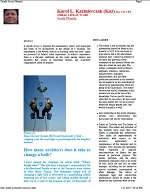 Facade Access
Facade Access Facade Engineering. How To Design a Functional Building Enclosure
Facade Engineering. How To Design a Functional Building Enclosure Facade Impact Resistance Manual
Facade Impact Resistance Manual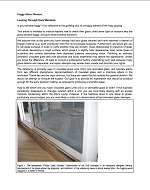 Foggy Glass Disease
Foggy Glass Disease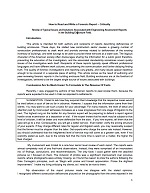 How To Write and Read a Forensic Report
How To Write and Read a Forensic Report Movements and Tolerances
Movements and Tolerances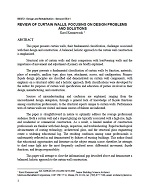 Review of Curtain Walls, Focusing on Design Problems and Solutions
Review of Curtain Walls, Focusing on Design Problems and Solutions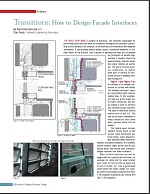 Transitions: How to Design Facade Interfaces
Transitions: How to Design Facade Interfaces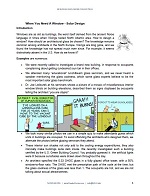 When You Need A Window – Solar Design
When You Need A Window – Solar Design
Leave a Reply
You must be logged in to post a comment.